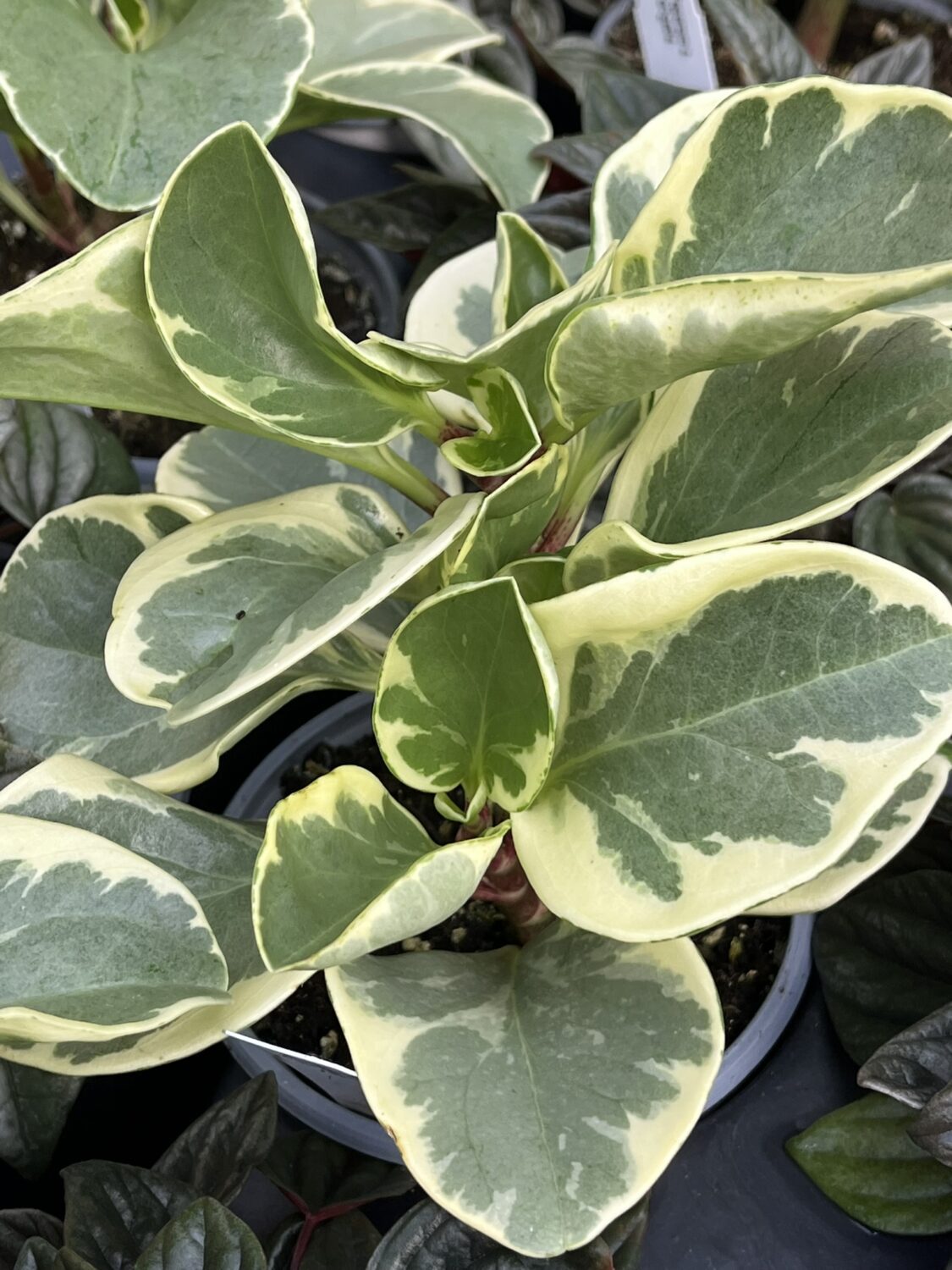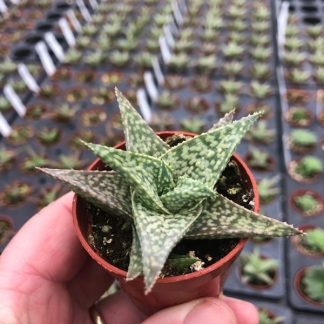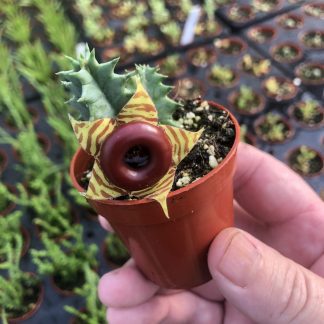Description
Peperomia obtusifolia ‘Variegata’: A Stunning and Low-Maintenance Houseplant
Peperomia obtusifolia ‘Variegata,’ often called the Variegated Baby Rubber Plant, is a houseplant that never fails to impress. Its thick, glossy leaves are splashed with soft cream, pale yellow, and deep green, forming natural patterns that look like brushstrokes. It’s a plant that feels both lush and elegant, but also incredibly easy to care for.
This plant is native to tropical and subtropical regions of South and Central America. In nature, you’ll find it tucked under trees, growing in the filtered light of warm, humid forests. Indoors, it brings that same soft tropical beauty to shelves, desks, and window ledges. Whether you’re just starting with plants or have a home full of them, this variety is a must-have.
Let’s dive into what makes Peperomia obtusifolia ‘Variegata’ so special, and explore everything you need to know to help it thrive in your space.
Why This Plant Stands Out
Beautiful Variegated Leaves
The first thing you’ll notice about this plant is its foliage. The oval-shaped leaves are thick and almost leathery to the touch. They shine naturally, even without polishing, and the colors are mesmerizing.
Variegation is what sets this variety apart. Each leaf is different. Some are streaked with cream, others have wide swaths of pale yellow, and many feature deep green edges or marbled centers. This variety of color adds instant texture and brightness to any room.
Compact and Versatile
Peperomia obtusifolia ‘Variegata’ stays small and tidy. Most plants grow no taller than 12 inches and spread about as wide. This size makes it perfect for shelves, windowsills, and tabletops. It’s also stunning in small hanging baskets, where its stems can drape gracefully over the sides as they grow.
Small Flowers, Big Sign of Health
While the foliage is the main star, you might notice thin, spiked flowers appearing from time to time. These greenish blooms aren’t showy, but they are a sign that your plant is happy and healthy. Many plant lovers see them as a quiet reward for good care.
Safe for Pets and Kids
A big plus for this plant is its safety. It’s non-toxic to pets and people, so you won’t have to worry if a curious child or cat takes a nibble.
Light: The Key to Vibrant Color
Light is the most important factor for this plant’s colorful leaves. Bright, indirect light will keep the variegation vivid. Without enough light, the cream and yellow tones can fade, leaving the plant mostly green.
-
Best spot: Place it near an east- or west-facing window. It loves soft morning or late-afternoon sun.
-
Avoid direct rays: Harsh midday sun can burn the leaves, leaving brown spots.
-
Low light: It can survive in lower light but will grow slower and may lose some of its patterns.
-
No windows? No problem. This plant also does well under fluorescent or LED grow lights, which makes it perfect for offices or rooms with few windows.
Temperature and Humidity: Tropical Comfort
This plant loves the same conditions most of us enjoy indoors.
-
Temperature: Keep it between 65°F and 80°F (18°C to 27°C). Avoid placing it in drafty spots or near vents where the air gets too hot or too cold.
-
Humidity: It tolerates average indoor humidity but thrives when it’s a bit higher. If your home is very dry, especially in winter, you can mist the leaves, place the plant near a humidifier, or set it on a pebble tray filled with water.
Soil and Potting: Well-Draining and Simple
Peperomia obtusifolia ‘Variegata’ is semi-succulent, meaning it stores water in its thick leaves. Because of this, it dislikes sitting in soggy soil.
-
Soil mix: Use a standard houseplant potting mix blended with perlite or coarse sand. A succulent or cactus mix also works well. The goal is fast drainage.
-
Pot choice: Always use a pot with a drainage hole. Terracotta pots work beautifully because they allow excess moisture to evaporate.
Watering: Less Is More
Overwatering is the most common mistake with this plant. Its thick leaves hold water, so it doesn’t need constant moisture.
-
How often to water: Let the top 1–2 inches of soil dry out before watering again. In spring and summer, this might be every 1–2 weeks. In fall and winter, water less often.
-
Check the soil: Stick your finger in the soil. If it feels dry at the top, it’s time to water.
-
Signs of overwatering: Yellow leaves, mushy stems, or a musty smell are red flags. Cut back on water and check for root rot if these signs appear.
Feeding: Boost Growth in the Warm Months
During the growing season (spring and summer), feed your plant once a month with a balanced, water-soluble fertilizer diluted to half strength. Skip feeding in fall and winter when growth naturally slows. This gentle approach prevents fertilizer burn and keeps your plant healthy without overloading it with nutrients.
Repotting: Every Few Years
This plant grows slowly and likes being slightly root-bound, so you won’t need to repot often. Every 2–3 years, or when roots start circling the bottom of the pot, repot into a container just one size larger. Always refresh the soil during this process to give your plant a nutrient boost.
Pruning: Keep It Tidy and Full
Pruning is simple and helps maintain a bushy shape. Snip off leggy stems or damaged leaves using clean scissors. Each cut encourages new growth and keeps the plant compact. The trimmings you remove can also be used for propagation, giving you new plants to share or keep.
Propagation: Multiply Your Collection
One of the joys of this plant is how easy it is to propagate. You can create new plants from stem or leaf cuttings. Here’s how:
-
Choose a healthy cutting: Select a stem or leaf with at least one node (the small bump where leaves grow).
-
Let it callus: Allow the cutting to dry for a few hours to prevent rot.
-
Plant or water-root: Place the cutting in moist soil or a jar of water. Keep it in bright, indirect light.
-
Wait for roots: Within 2–4 weeks, roots will appear. Once the roots are a few inches long, transfer water-rooted cuttings into soil.
This process is rewarding and a fun way to expand your collection or give gifts to friends and family.
Common Problems and Simple Fixes
Even though this plant is low-maintenance, a few issues can pop up:
-
Yellowing leaves: Usually caused by overwatering. Let the soil dry out more between waterings.
-
Brown leaf edges: Can signal low humidity or underwatering. Mist the plant or water a bit more often.
-
Pests: Rare, but mealybugs and spider mites may appear. Wipe leaves with a damp cloth and treat with neem oil or insecticidal soap.
-
Root rot: Happens when soil stays too wet. Remove damaged roots, repot in fresh, well-draining soil, and reduce watering.
Styling Ideas for Your Home
Peperomia obtusifolia ‘Variegata’ is as versatile as it is beautiful. Here are some creative ways to display it:
-
Minimalist look: Place it in a simple white or gray pot to highlight its variegated leaves.
-
Hanging planter: Let the stems trail from a macrame hanger or wall-mounted basket.
-
Desk companion: Its small size makes it perfect for workspaces, adding greenery without clutter.
-
Grouped display: Pair it with other small tropical plants, such as peperomias or succulents, for a colorful arrangement.
Why You’ll Love Growing This Plant
This plant checks so many boxes:
-
Beginner-friendly: It forgives missed waterings and adapts well to different light levels.
-
Compact size: Perfect for apartments or small spaces.
-
Safe for pets and children: No worries about toxic leaves.
-
Air-purifying: Helps freshen your indoor air naturally.
-
Beautiful year-round: Its variegated leaves stay attractive in every season.
Embrace Its Simple Beauty
Peperomia obtusifolia ‘Variegata’ is proof that low-maintenance plants can also be strikingly beautiful. Its marbled leaves bring light and movement into any space. Its forgiving nature makes it a joy for both new and seasoned plant parents.
By giving it bright, indirect light, well-draining soil, and occasional water, you’ll enjoy a plant that thrives for years. And as you prune, propagate, and style it in your home, it becomes more than just greenery — it becomes part of your daily rhythm, quietly softening your space and brightening your mood.
If you’re looking for a plant that’s compact, colorful, and nearly effortless to care for, this is the one to bring home. Once you welcome it in, you’ll see why it’s loved by plant enthusiasts everywhere.




